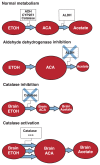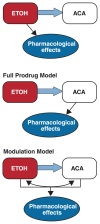Role of acetaldehyde in mediating the pharmacological and behavioral effects of alcohol
- PMID: 17718404
- PMCID: PMC6527032
Role of acetaldehyde in mediating the pharmacological and behavioral effects of alcohol
Abstract
Acetaldehyde is the first active breakdown product (i.e., metabolite) generated during alcohol metabolism. It has toxic properties but also exerts other actions on the body (i.e., has pharmacological properties). Recent studies have shown that the direct administration of acetaldehyde, especially into the brain, induces several effects that mimic those of alcohol. High doses of acetaldehyde induce sedative as well as movement- and memory-impairing effects, whereas lower doses produce behavioral effects (e.g., stimulation and reinforcement) that are characteristic of addictive drugs. When acetaldehyde accumulates outside the brain (i.e., in the periphery), adverse effects predominate and prevent further alcohol drinking. To investigate the role of acetaldehyde in mediating alcohol's effects, investigators have pharmacologically manipulated alcohol metabolism and the production of acetaldehyde within the body (i.e., endogenous acetaldehyde production). Studies manipulating the activity of the enzyme catalase, which promotes acetaldehyde production in the brain, suggest that acetaldehyde contributes to many behavioral effects of alcohol, especially its stimulant properties. However, it remains controversial whether acetaldehyde concentrations obtained under normal physiological conditions are sufficient to induce significant pharmacological effects. Current evidence suggests that the contribution of acetaldehyde to alcohol's effects is best explained by a process in which acetaldehyde modulates, rather than mediates, some of alcohol's effects.
Conflict of interest statement
The authors declare that they have no competing financial interests.
Figures


Similar articles
-
The role of acetaldehyde in the neurobehavioral effects of ethanol: a comprehensive review of animal studies.Prog Neurobiol. 2005 Mar;75(4):247-74. doi: 10.1016/j.pneurobio.2005.03.003. Epub 2005 Apr 26. Prog Neurobiol. 2005. PMID: 15882776 Review.
-
Ethanol as a prodrug: brain metabolism of ethanol mediates its reinforcing effects--a commentary.Alcohol Clin Exp Res. 2011 Apr;35(4):581-3. doi: 10.1111/j.1530-0277.2011.01454.x. Epub 2011 Feb 25. Alcohol Clin Exp Res. 2011. PMID: 21352247
-
Oxidation of ethanol in the brain and its consequences.Alcohol Res Health. 2006;29(4):266-73. Alcohol Res Health. 2006. PMID: 17718405 Free PMC article. Review.
-
Genetic polymorphism in ethanol metabolism: acetaldehyde contribution to alcohol abuse and alcoholism.Mol Psychiatry. 2004 Jun;9(6):570-81. doi: 10.1038/sj.mp.4001497. Mol Psychiatry. 2004. PMID: 15164086 Review.
-
Ethanol as a prodrug: brain metabolism of ethanol mediates its reinforcing effects.Alcohol Clin Exp Res. 2011 Apr;35(4):606-12. doi: 10.1111/j.1530-0277.2011.01439.x. Epub 2011 Feb 17. Alcohol Clin Exp Res. 2011. PMID: 21332529 Free PMC article.
Cited by
-
Alcohol and acetaldehyde in public health: from marvel to menace.Int J Environ Res Public Health. 2010 Apr;7(4):1285-301. doi: 10.3390/ijerph7041285. Epub 2010 Mar 25. Int J Environ Res Public Health. 2010. PMID: 20617031 Free PMC article. Review.
-
Significance of Exhaled Breath Test in Clinical Diagnosis: A Special Focus on the Detection of Diabetes Mellitus.J Med Biol Eng. 2016;36(5):605-624. doi: 10.1007/s40846-016-0164-6. Epub 2016 Oct 11. J Med Biol Eng. 2016. PMID: 27853412 Free PMC article. Review.
-
Relationship between moderate alcohol consumption, genetic polymorphisms and body weight in a population sample of Puerto Madryn, Argentina.Biomedica. 2024 Nov 6;44(4):510-523. doi: 10.7705/biomedica.7270. Biomedica. 2024. PMID: 39531551 Free PMC article. English, Spanish.
-
Association Between Dietary Alcohol Intake and Migraine or Severe Headache Miscellaneous Pain: The NHANES 1999-2004.Brain Behav. 2025 Mar;15(3):e70400. doi: 10.1002/brb3.70400. Brain Behav. 2025. PMID: 40083275 Free PMC article.
-
Neuropharmacology of Alcohol Addiction with Special Emphasis on Proteomic Approaches for Identification of Novel Therapeutic Targets.Curr Neuropharmacol. 2023;21(1):119-132. doi: 10.2174/1570159X20666220811092906. Curr Neuropharmacol. 2023. PMID: 35959616 Free PMC article.
References
-
- Aragon CMG, Amit Z. The effect of 3amino-1,2,4-triazole on voluntary ethanol consumption: Evidence for brain catalase involvement in the mechanism of action. Neuropharmacology. 1992;31:709–712. - PubMed
-
- Aragon CMG, Pesold CN, Amit Z. Ethanol-induced motor activity in normal and acatalasemic mice. Alcohol. 1992;9:207–211. - PubMed
-
- Arizzi-LaFrance MN, Correa M, Aragon CMG, Salamone JD. Motor stimulant effects of ethanol injected into the substantia nigra pars reticulata: Importance of catalase-mediated metabolism and the role of acetaldehyde. Neuropsychopharmacology. 2006;31:997–1008. - PubMed
-
- Belluzzi JD, Wang R, Leslie FM. Acetaldehyde enhances acquisition of nicotine self-administration in adolescent rats. Neuropsychopharmacology. 2005;30:705–712. - PubMed
-
- Brown ZW, Amit Z, Rockman GE. Intraventricular self-administration of acetaldehyde, but not ethanol, in naïve laboratory rats. Psychopharmacology. 1979;64:271–276. - PubMed
Publication types
MeSH terms
Substances
LinkOut - more resources
Full Text Sources
Medical
